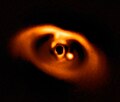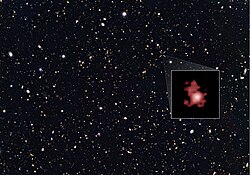| Observation data Epoch J2000.0 Equinox J2000.0 | |
|---|---|
| Constellation | Cygnus [1] |
| Right ascension | 19h 41m 55.76712s [2] |
| Declination | +48° 31′ 27.9998″ [2] |
| Apparent magnitude (V) | 14.769±0.206 [3] |
| Characteristics | |
| Evolutionary stage | subgiant [2] |
| Spectral type | G [4] |
| Apparent magnitude (J) | 13.550±0.023 [5] |
| Apparent magnitude (H) | 13.204±0.024 [5] |
| Apparent magnitude (K) | 13.138±0.035 [5] |
| Variable type | Planetary transit [3] |
| Astrometry | |
| Proper motion (μ) | RA: −5.092 mas/yr [2] Dec.: +5.839 mas/yr [2] |
| Parallax (π) | 0.6462±0.0165 mas [2] |
| Distance | 5,000 ± 100 ly (1,550 ± 40 pc) |
| Details | |
| Mass | 1.03 [6] M☉ |
| Radius | 1.62 [6] R☉ |
| Luminosity | 2.59 [6] L☉ |
| Surface gravity (log g) | 4.03 [6] cgs |
| Temperature | 5,745 [6] K |
| Metallicity [Fe/H] | −0.76+0.32 −0.26 [7] dex |
| Rotation | 27.7 days [8] |
| Rotational velocity (v sin i) | 2.25 [9] km/s |
| Age | 5.7+5.1 −2.6 [7] Gyr |
| Other designations | |
| KOI-5856, KIC 11037818, 2MASS J19415577+4831280 [10] | |
| Database references | |
| SIMBAD | data |
Kepler-1638 is a G-type subgiant star located about 5,000 light years away in the constellation of Cygnus. [1] One known exoplanet has been found orbiting the star: Kepler-1638b. [11] [12] [13] [14] As of January 2021, Kepler-1638 is the farthest star with a known exoplanet orbiting in the habitable zone. [15]




